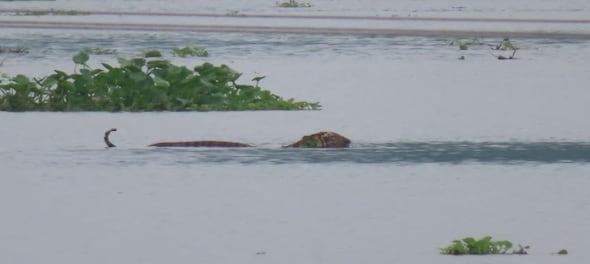
“Everyone in our family has seen a tiger, but today my mother could touch one, she patted on its back,” said Kamal Sharma who hosted a Royal Bengal tiger at his house in Kandhulimari village of Assam’s Golaghat district on Monday.
A sub-adult tiger swam into the peripheral village, just 200 metres from the flooded Agaratoli range of Kaziranga National Park, and took shelter under the thatched goat-shed inside Sharma’s house. It stayed all night in close proximity with the goats before returning to the highlands next day at dusk - causing no harm to livestock or humans.
“We heard noises at around 1:30am, but I did not bother to look. Next morning, we saw fresh pug marks on ground, and believed it was a tiger that might have rested for a while and gone. My mother went inside the goat-shed to feed them hay and clean it when she saw a sack like object lying below in water. She touched it and without uttering a word hurried back to the house. She was shivering for nearly 15 minutes and told us it was a tiger,” said Sharma, a dairy farmer in the area.
“I saw the tiger from three feet distance. It was sleeping. My mother said it was heavily panting in the morning. The poor animal must have been tired, and it rested in my courtyard – a very safe place for it to be,” exclaimed Sharma.
The tiger had strayed out from the submerged areas inside the forest to move to the higher reaches as flood in Assam has inundated nearly 95 percent of Kaziranga National Park and Tiger Reserve. Finding no other place, the big cat took shelter beneath the fenced goat-shed with only its head sticking out of the water. After an 11-hour wait, the animal was given safe passage.
Sharma had called the Forest Department helpline number to report the incident. A team of officials led by Ranger Bidyut Bikash Bora of Eastern Range reached the spot and immediately cordoned off the area. He was joined by the Director of Kaziranga National Park, P Sivakumar and Divisional Forest Officer, Ramesh Kumar Gogoi. The crowd that had gathered around the place was cleared by forest guards.
An expert team from the Centre for Wildlife Rehabilitation and Conservation (CWRC), the lead agency that takes charge of such rescue operations also reached the spot.
“The tiger wanted to go to the highland as there is water inside the park. Because it was tired and stressed out, it took rest under this Machaan, the goat-shed. We first set the goats free by cutting off the ropes. And we also wanted to give a safe passage to the tiger so that it can swim back to the park or move towards the highland. Tranquilising the animal was not required as there was water all around, and the shed was barricaded,” explained Dr Samshul Ali, wildlife vet who was part of another well-orchestrated rescue of a Royal Bengal tiger that had moved out of Bagori range of Kaziranga during floods last year.

All the while, foresters stood guard outside Sarma’s house and waited for the tiger to come out in the evening.
“The villagers fully cooperated in this rescue mission. We did not need to tranquilize the tiger. We were hopeful it would make its way back into the park, and it did,” said Director P Sivakumar, adding that it was a bigger challenge last year because of the crowd that had gathered outside the residence of the villager in whose house a tiger had taken shelter atop a bed. A safe passage was also given to the tiger then.
On Tuesday, two tigers strayed out of the park’s Western Range and approached the Baghmari village area. At the time of filing this report, one of the tigers was chased away towards the Karbi Anglong Hills, and another is said to be resting near the National Highway 37, according to officials.
“Because of floods, the animals are trying to move to the higher reaches of Karbi hills through NH-37. One tiger was disturbed by the stray dogs in the fringe village but has now crossed the road and safely reached the hills.
Another is still resting near the highway and tried to attack people, so we have stopped traffic and will try to chase it to the hills,” said Sivakumar.
According to latest reports, 51 animals have died in Kaziranga National Park due to floods this year. While 14 anti-poaching camps have been vacated, 223 camps in Agaratoli, Bagori, Burapahar and Bokakhat ranges of the park under Eastern Assam Division, Biswanath and Nagaon Wildlife Divisions have been inundated.
With help from locals, over a hundred animals have been rescued so far by forest officials and the CWRC team, and 83 animals have been released after treatment. Since the past four days, the Brahmaputra is still flowing above the danger level at Neematighat in Jorhat district, Dhansirimukh in Golaghat and Tezpur in Sonitpur district of Assam.
(With inputs from Pradyut Mahanta)
First Published: Jul 14, 2020 6:33 PM IST
Check out our in-depth Market Coverage, Business News & get real-time Stock Market Updates on CNBC-TV18. Also, Watch our channels CNBC-TV18, CNBC Awaaz and CNBC Bajar Live on-the-go!


2024 Lok Sabha Elections | Why Kerala is in focus as the second phase begins to vote
Apr 26, 2024 9:33 AM
Bengaluru Rural Lok Sabha election: Over 20% voter turnout recorded by 11 am
Apr 26, 2024 9:11 AM

